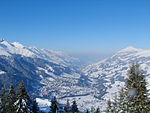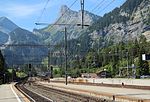Gross Lohner

The Gross Lohner (also spelled Gross Loner, German: Great Lohner), is a limestone mountain of the Bernese Alps, located between Adelboden and Kandersteg in the Bernese Oberland. The main summit has an elevation of 3,048.7 metres (10,002 ft) above sea level and is distinguished by the name Vorder Lohner ("Fore Lohner"). The mountain features several other peaks, from east to west: Nünihorn, 2,717 metres (8,914 ft) Hinder Lohner (Rear Lohner), 2,929 metres (9,610 ft) Mittler Lohner (Central Lohner), 3,002 metres (9,849 ft) Mittaghorn, 2,678 metres (8,786 ft)The Lohner range is located east of Adelboden in the Engstlige valley and southwest of Kandersteg in Kander valley. The Gross Lohner is separated from the Chlyne Lohner (Small Lohner) to the north by the Bunderchrinde Pass, which provides a hiking route between Adelboden and Kandersteg.The first tourist to climb the Lohner was one C. Dürheim from Bern in July 1876. In August of the same year, four members of the Alpine Club, during another ascent, found a bottle with the names of the two Kandersteg mountain guides Ogi and Hari, dated 1875.Approximately halfways up the rock face, the Lohner hut can be found, which can be reached by skilled hikers without proper climbing. The mountain with its many screes is almost only accessible by one of its three ridges. From the Lohner hut, the Mittler Lohner can be reached via the face by skilled climbers.
Excerpt from the Wikipedia article Gross Lohner (License: CC BY-SA 3.0, Authors, Images).Gross Lohner
Geographical coordinates (GPS) Address Nearby Places Show on map
Geographical coordinates (GPS)
| Latitude | Longitude |
|---|---|
| N 46.4625 ° | E 7.6 ° |
Address
Holzbärg
3715
Bern, Switzerland
Open on Google Maps









